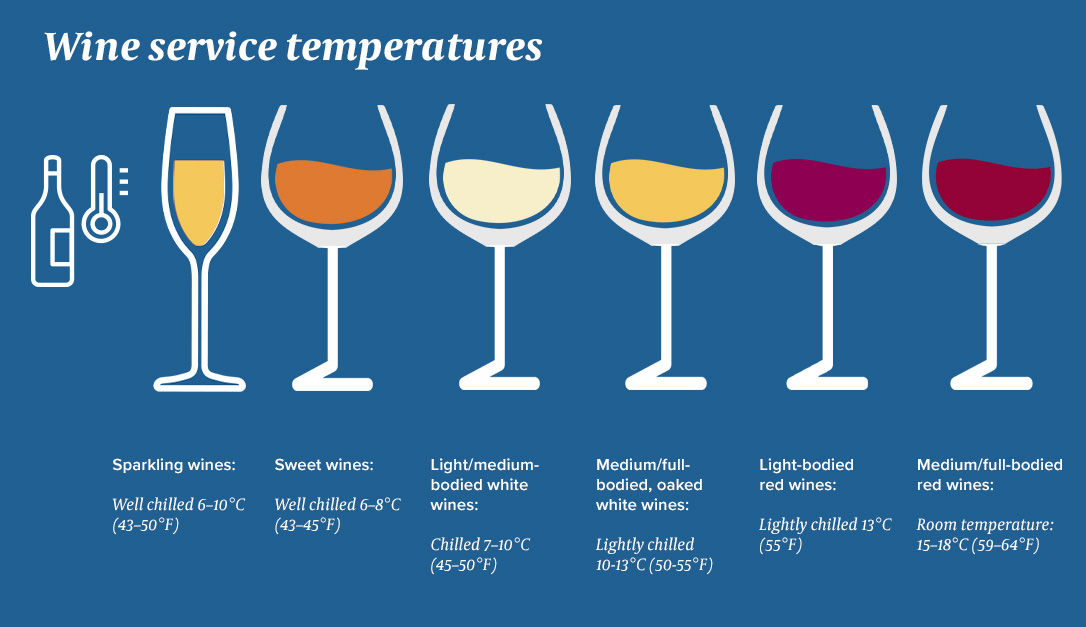We independently evaluate all recommended products and services. If you click on links we provide, we may receive compensation. Learn more .
One of the biggest factors that impacts the way we experience wine is serving temperature. In fact, many wine professionals believe that getting the temperature right is the single most important factor for optimal enjoyment of wine. Conventional wisdom says to serve white wines chilled and reds at room temperature, but most white wines are served too cold and red wines are often served too warm because homes are kept much warmer than in the past. Here, we take a look at the proper serving temperature for each style of wine; were also sharing some helpful tips on chilling wine quickly and efficiently.
Lighter, fruitier, and drier white wines such as Pinot Grigio and Sauvignon Blanc are ideal at colder temperatures, usually between 45-50 degrees. Bubbly bottles such as Champagne, Prosecco, sparkling brut, and sparkling rosés should always be chilled to 40-50 degrees.

White Wines
Most white wines are ideally served at 45-50 degrees—much warmer than the temperature of your refrigerator which typically will be 37-40 degrees. This is because the colder the temperature, the more muted the flavors will be. (Theres a reason super cheap beer is served ice cold!) Its really a matter of personal preference but fuller and richer wines should be served warmer than light and crisp wines. Fuller bodied whites like chardonnay can be enjoyed a little warmer, between 50-60 degrees.
If you store a white wine in the refrigerator, try removing it about 20 minutes before you plan on drinking it to let it warm up slightly. If you order a white wine at a restaurant and it comes out ice cold, ask to keep the bottle on the table instead of in an ice bucket, and enjoy how the flavors come alive as the wine gradually warms up throughout your meal. If it gets too warm for your personal preference, put it back on ice for a few minutes. And if the wine is at its optimal temperature, make sure to always hold the glass by the stem to prevent the heat from your hands warming up the wine!
To achieve the best temperature for white wines, you will want to put the bottle in the refrigerator for 2.5 hours, in the freezer for 20-25 minutes, or submerged in ice water for 10 minutes.
Red Wines
Red wines should be served between 55 and 65 degrees, with lighter reds on the cooler end of the range and full bodied reds on the warmer side. If red wine is served at room temperature, it can taste a bit flabby and sometimes the perception of alcohol is emphasized, throwing the wine off balance. To get the right temperature—just slightly cool—put the bottle in the fridge for 20 minutes, in the freezer for 5-6 minutes, or submerged in ice water for 3 minutes.
True or False – All white wines should be chilled the same
FAQ
Do all white wines need to be chilled?
What are examples of white wine that should always be served chilled?
Should Chardonnay be chilled?
What wines should not be chilled?
Should white wine be chilled?
So as a general rule, while it is generally safe to say that all white wines should be chilled, the perfect temperature serves to better accentuate the acidity and the fruit flavors of the wine. If you are enjoying a bottle of white wine on its own, you might not necessarily care too much about achieving the perfect temperature.
Red vs White wine: Which is healthier?
The difference between red and white wine is the colour of the grapes which are used. To make white wine, grapes are pressed and skin, seeds and stems are removed before fermentation. However, to make red wine, the crushed red grapes are fermented with seeds, skin and stems. As a result, red wine is rich in plant compounds that are present in those skins such as tannins and resveratrol. Overall, red wine has slight edge over white because it has higher amounts of vitamins and minerals. Red wine helps in reducing heart disease risk, increase good HDL cholesterol and helps with diabetes. Red wine helps with cancer and eases joint pain.
What wine needs a chill?
White, Rosé and Sparkling Wine: Whites need a chill to lift delicate aromas and acidity. However, when they’re too cold, flavors become muted. Like reds, fuller-bodied wines like Chardonnay from Burgundy and California shine between 50°F and 60°F. Dessert wines like Sauternes fall into the same range.
How do you chill white wine?
The most common approach to chilling white wine is to remove it from the refrigerator and serve immediately. This results in white wine with dull, muted flavors and lackluster acidity. Most refrigerators operate around 37-40 degrees Fahrenheit while the majority of white wines like to be served slightly warmer around 45-50°.
